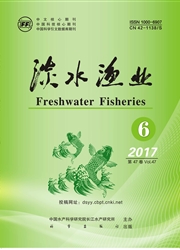

 中文摘要:
中文摘要:
观察了水温(18±1)℃条件下,小体鲟(Acipenser ruthenus Linnaeus)的胚胎发育特征。结果显示:成熟小体鲟卵圆球形、黑色、不透明,为粘性卵,卵径2.2—2.8mm。水温(18±1)℃条件下,小体鲟受精卵历时110h孵化出膜,所需总积温为2023~2308℃·h。小体鲟受精卵的卵裂方式为特殊的辐射状卵裂;原肠中期时动物极细胞覆盖胚胎三分之二;心跳期,心脏呈C型;尾端接近心脏时,眼囊内已经有色素沉着。根据胚胎发育过程的形态特征,可将小体鲟胚胎发育过程分为受精卵、卵裂、囊胚、原肠、神经胚、器官发生和出膜7个连续阶段,34个时期。另外,本研究还将小体鲟胚胎发育和鲟形目其他鱼类胚胎发育特征进行了对比分析。
 英文摘要:
英文摘要:
The embryonic development characteristics of starlet (Acipenser ruthenus Linnaeus) were studied, under the water temperature 18 ± 1℃. The results showed that the fully mature eggs were spherical, black, opacity, sticky, and 2.2 - 2. 8 mm in diameter, it took 110 h from fertilization to hatching-out with the average aeumulative temperature of 2023 - 2308 ℃ · h. The cleavage pattern of starlet were peculiar radial holoblasfic cleavage. The cells of animal pole had twothirds covered the whole embryon at midgastrula stage. The heart were C type at stage of heart beating. The optic capsule had had pigment when the tail end approached heart. The embryonic development process could be divided into 7 stages, including fertilized egg stage, cell division stage, blastula stage, gastrula stage, neurtda stage, organ formation stage and hatching stage. They contained thirty-four developing phases, whose characteristics were described in detail. In addition, the embryonic development characteristics of sterlet and other sturgeons were comparatively analysed in this paper.
 同期刊论文项目
同期刊论文项目
 同项目期刊论文
同项目期刊论文
 期刊信息
期刊信息
